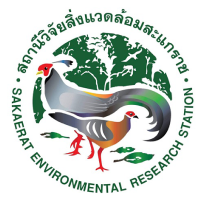Keywords :
Camera Trapping; Least Concern; Predator-prey; Prey Availability; Rodent Biomass; Sakaerat Biosphere Reserve; Southeastern Asia; Spatally-explicit Capture-recapture
บทคัดย่อ :
The Leopard Cat Prionailurus bengalensis is thought to be Asia s most abundant wild cat. Yet, the species status is poorly known
due to a lack of rigorous populaton estmates. Based on the few studies available, Leopard Cats appear to be more abundant in degraded
forests, potentally due to increased prey availability. We conducted camera trap surveys, rodent live-trapping, and spatally-explicit
capture-recapture analyses to estmate the density of Leopard Cats within a degraded tropical forest fragment (148km2
) in northeastern
Thailand. A total efort of 12,615 camera trap nights across 65km2
of trapping area resulted in at least 25 uniquely identfed individuals.
Average rodent biomass (the main prey of Leopard Cats) was highest in the dry evergreen forest (469.0g/ha), followed by dry dipterocarp
forest (287.5g/ha) and reforested areas (174.2g/ha). Accordingly, Leopard Cat densites were highest in the dry evergreen forest with 21.42
individuals/100km2
, followed by the reforested areas with 7.9 individuals/100km2
. Only two detectons came from the dry dipterocarp
forest despite both an extensive survey efort (4,069 trap nights) and available prey. Although the dipterocarp supported the second
highest average rodent biomass, it lacked a key prey species, Maxomys surifer, possibly explaining low encounter rates in that habitat.
Our results provide important baseline informaton concerning the populaton status of Leopard Cat in southeastern Asia. Further, our
fndings corroborate with other studies that found a tolerance among Leopard Cats for degraded forests, highlightng the potental for
forest fragments to serve as long-term conservaton areas for the species.
เอกสารอ้างอิง :
Petersen, W. J., Savini, T., Steinmetz, R., & Ngoprasert, D. (2019). Estimating Leopard Cat Prionailurus bengalensis Kerr, 1792 (Carnivora: Felidae) density in a degraded tropical forest fragment in northeastern Thailand. Journal of Threatened Taxa, 11(4), 13448-13458.



